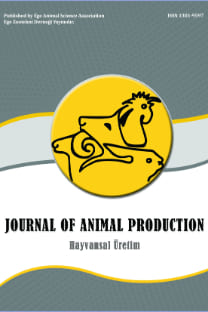Pırlak koyunlarında HSP90AA1 gen bölgesindeki genetik varyasyonlar
Pırlak koyunu, AS-PZR, karakterizasyon, ısı stresi, ısı toleransı, HSP90AA1, polimorfizm
Genetic Variations in HSP90AA1 Gene Region in Pırlak Sheep Breed
Pırlak sheep, AS-PCR, characterization, heat stress, heat tolerance, HSP90AA1, polymorphism,
___
- Badri TM, Chen KL, Alsiddig MA, Li L, Cai Y, Wang GL. 2018. Genetic polymorphism in Hsp90AA1 gene is associated with the thermotolerance in Chinese Holstein cows. Cell Stress and Chaperones 23: 639-651.
- Chen ZY, Gan JK, Xiao X, Jiang LY, Zhang XQ, Luo QB. 2013. The association of SNPs in Hsp90β gene 5′ flanking region with thermo tolerance traits and tissue mRNA expression in two chicken breeds. Molecular Biology Reports, 40: 5295-5306.
- Çelikeloğlu K, Erdoğan M, Hacan Ö, Koçak S, Bozkurt Z, Tekerli M. 2018. Pırlak koyunlarında BMPR1B, BMP15 ve GDF9 genlerinde olası polimorfizmlerin araştırılması. Kocatepe Veterinary Journal 11(4): 356-362.
- Demir E, Bilginer U, Balcioglu MS, Karsli T. 2021. Direct and indirect contributions of molecular genetics to farm animal welfare: a review. Animal Health Research Reviews 22(2): 177-186.
- Demir E, Ceccobelli S, Bilginer U, Pasquini M, Attard G, Karsli T. 2022. Conservation and selection of genes related to environmental adaptation in native small ruminant breeds: a review. Ruminants 2(2): 255-270.
- Hoffmann G, Herbut P, Pinto S, Heinicke J, Kuhla B, Amon T. 2020. Animal-related, non-invasive indicators for determining heat stress in dairy cows. Biosystems Engineering 199: 83-96.
- Karsli BA, Demir E, Fidan HG, Karsli T. 2020. Assessment of genetic diversity and differentiation among four indigenous Turkish sheep breeds using microsatellites. Archives Animal Breeding 63(1): 165-172.
- Kumar D, Yadav B, Choudhury S, Kumari P, Madan AK, Singh SP, Routh PK, Ramchandran N, Yadav S. 2018. Evaluation of adaptability to different seasons in goat breeds of semi-arid region in India through differential expression pattern of heat shock protein genes. Biological Rhythm Research 49(3): 466-478.
- Marcos-Carcavilla A, Calvo JH, González C, Moazami-Goudarzi K, Laurent P, Bertaud M, Hayes H, Beattie AE, Serrano C, Lyahyai J, Martín-Burriel I, Serrano M. 2008. Structural and functional analysis of the HSP90AA1 gene: distribution of polymorphisms among sheep with different responses to scrapie. Cell Stress and Chaperones 13: 19-29.
- Miller S, Dykes D, Polesky H. 1988. A simple salting out procedure for extracting DNA from human nucleated cells. Nucleic Acids Research 16(3): 1215-1215.
- Niyas PA, Chaidanya K, Shaji S, Sejian V, Bhatta R. 2015. Adaptation of livestock to environmental challenges. Journal of Veterinary Science and Medical Diagnosis 4(3): 1-7.
- Oner Y, Calvo JH, Serrano M, Elmaci, C. 2012. Polymorphisms at the 5′ flanking region of the HSP90AA1 gene in native Turkish sheep breeds. Livestock Science 150(1-3): 381-385.
- Park H, Ahn IY, Lee HE 2007. Expression of heat shock protein 70 in the thermally stressed Antarctic clam Laternula elliptica. Cell Stress and Chaperones 12(3): 275-282.
- Peakall R, Smouse PE 2012. GenAlEx 6.5: genetic analysis in Excel. Population genetic software for teaching and research - an update. Bioinformics 28: 2537-2539.
- Salces-Ortiz J, Ramon M, Gonzalez C, Perez-Guzman MD, Garde JJ, Garcia-Alvarez O, Maroto-Morales A, Calvo JH, Serrano MM. 2015. Differences in the ovine HSP90AA1 gene expression rates caused by two linked polymorphisms at its promoter affect rams sperm DNA fragmentation under environmental heat stress conditions. PLoS One 10(2): e0116360.
- Sancar MC, Güngör Ş. 2022. Analysis of Antalya province bioclimatic comfort features according to heat index. International Journal of Eurasia Social Sciences 13(48): 710-723.
- Singh KM, Singh S, Ganguly I, Nachiappan RK, Ganguly A, Venkataramanan R, Chopra A, Narula HK. 2017. Association of heat stress protein 90 and 70 gene polymorphism with adaptability traits in Indian sheep (Ovis aries). Cell Stress and Chaperones 22: 675-684.
- ISSN: 1301-9597
- Başlangıç: 1974
- Yayıncı: EGE ZOOTEKNİ DERNEĞİ
Pırlak koyunlarında HSP90AA1 gen bölgesindeki genetik varyasyonlar
Kadriye Gül YURDAGÜL, Sude ATAY, Ümit BİLGİNER, Taki KARSLI, Eymen DEMİR
Emel ÖZCAN GÖKÇEK, Raziye IŞIK
Hüseyin Cem GÜLER, Çiğdem ŞEREMET
Tuğçe TURGUT, Ayşe Nur TANIŞ, Emin ÖZKÖSE, Mehmet Sait EKİNCİ
Yumurta Kabuğunun Yapısı ve Mikrobiyal Kontaminasyon Yolları
İlayda ÖZÇEVİK, Serol KORKMAZ, Burcu İrem OMURTAG KORKMAZ
Yapay Zeka Teknolojilerinin Hayvancılıkta Kullanımı
Niyazi Hayrullah TUVAY, Orhan ERMETİN
Yalova Kıvırcık Kuzularında Bel Göz Kası Ultrasonik Ölçümleri, Canlı Ağırlık ve Bazı Vücut Ölçüleri
Emre ALARSLAN, Turgut AYGÜN, Nurgül KAÇAR
Kanatlı Hayvanlarda Embriyo Kayıpları
Esra ÜNBAŞ, Coşkun KONYALI, Türker SAVAŞ
Hakkâri İli Küçükbaş Hayvancılık İşletmelerinin Yapısal Özellikleri
